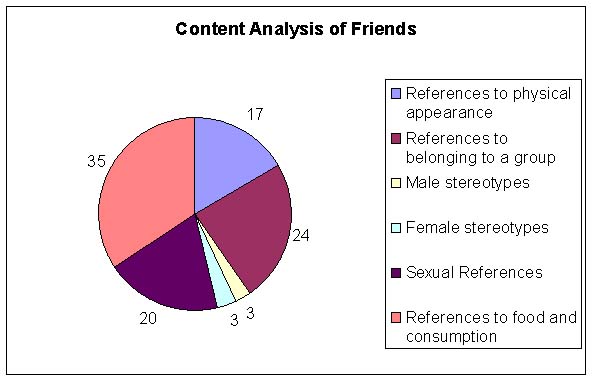
| SOSC
4318: Modes of Communication: "Reading Television?" Friends |

| Frasier |
| Friends.1 |
| Friends.2 |
| Simpsons |
| Sopranos |
| That 70's Show |

CONTENT ANALYSIS
Stefan Herrmann said it best when he argued that television is not
a passive process since we “have to learn to interpret the images
shown on TV to be able to understand them.” This is done in the same
way that we had to learn the alphabet and language to be able to read
a book (Herrmann,
2000). Our involvement is so natural that we do not realize how active
our attention is during a show, an ad, or any representation of images
on the television screen. Content analysis stems from this involvement.
It questions whether quantity has the power to influence the viewer in
an almost “brainwashing” manner. Yet, when asked, many viewers
would continue to argue that television is “an escape” from
our busy lives. When we watch TV, we are relaxed and completely passive—often
not paying attention to the activity on the screen.
We have approached a contradiction in views and we must now evaluate which
perspective is in fact correct—that of the theorist, or the viewers?
To test this theory out, I looked at the popular television sitcom Friends
and conducted an analysis of the content of the episode entitled "the
one with the rumour".

My hypothesis:
"If we are as inactive as we claim to be while watching television, then why is it that theorists have been able to prove time and again that television affects us on a psychological level?”
I began by organizing categories to be used in coding the images. The categories were carefully chosen as topics that were both typical to the genre and appropriate for the hypothesis. Since “your typical US sitcom runs about 22 minutes, not counting commercials, network promos, teasers, opening titles and closing credits (Spadoni, 2002), we will consider the results to be per 22 minutes. I realize that an in-depth study of the content of a program normally involves many samples to be analyzed, but this is simply an introduction to the theory of Content Analysis and I would like to apologize if I have insulted the work of any professional by minimizing it to a mere 22 minute sample.
The Analysis:
1. In my first analytical viewing, I looked for References to physical appearances. My reasoning— “Society pays a significant amount of attention to body image and physical attractiveness, youthfulness, sexuality, and appearance” (Kuehnel,1998). A beautiful woman or a sexy man will grab the viewer’s attention quickly and instantly in almost every case. Yet, when we see an attractive individual, we often look at them in admiration and hope to look equally or more attractive. Though most of us feel that we do not.
2. For my second analytical viewing, I searched for References to belonging in a group. Maslow’s Hierarchy of Needs proves the importance of this need to humans. We thrive on being accepted into a group of some sort.Television shows are often seen when we come home from work or school when we are alone. These depictions of the importance of groups have the potential to emphasize our solitude at that time.
3. For my third analytical viewing, I searched for Male stereotypes. My reasoning—we find sexist jokes to be humorous. After we laugh, we choose whether or not to take the joke seriously or pass it off as nonsense humour—this definitely requires some level of thought.
4. For my fourth analytical viewing, I searched for Female stereotypes for the same reasons as above (I just wanted to make it equal!).
5. My fifth analytical viewing involved a search for Sexual References. There is no question that sex appeals to most viewers—this has been proven time and again! It is, however, a type of attention that captures all the senses and draws the viewer in unconsiously, yet brilliantly!
6. "Food and Consumption" is the theme of my sixth analytical viewing. This is another unconscious attention-getter that draws us in subtly and brilliantly. Many of us are driven by our stomachs-- whether this serves as a physical and emotional threat is the theme of the next portion of my research.

The Results:

In Conclusion:
I felt that this episode was an important one to analyze as Neilson Media Research indicated that it was not only one of the highest rated episodes of Friends, but it also held the number one slot for ratings when compared with other shows. We may therefore assume that Friends consists of content that is viewed by large populations of individuals. How deeply is this content absorbed by these viewers? Well it has been proven that society is influenced by various forms of media. People begin to question their body image as references are made to food, appearance, sexuality and acceptance. When the references are repeated over and over again as the above chart indicates, the invoked images are reinforced in our unconscious minds. Rather than relaxing our nerves, television could therefore serve as a negative influence on our psychological health causing eating disorders and other such potentially fatal illnesses. As we view the images and text, we connotatively and denotatively interpret all that is presented to us. The problem lies in our connotative interpretation of the texts. I found a great deal of difficulty in viewing the television show for a content analysis study simply because of the connotative meanings that I would constantly apply. In the end, I was able to do it-- though it required some degree of mental separation from the text. When we watch television to supposedly relax, we rarely put the effort into separating ourselves from the images that we see and the words that we hear. Commenting on an outfit that we see or laughing at a joke that we hear proves that we are thinking about the text-- however minute the thought may seem. It is this very thought process that Stephan Hermann argues about. Simply stated-- it is nearly impossible for us to watch television without interpreting the images and verbals in some way. A simple content analysis study unconsciously proved this to me.
-Gina Mani


| Home | Assignment Purpose | Theory Summaries | Who We Are |

